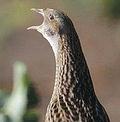 英國政府負責「生物多樣性夥伴關係」的機關19日公佈的一份研究報告,其中指出,每年定期在英國繁殖的全球最受威脅鳥類,在保育努力下數量已逐漸增加,而其他生物的復育情況也都陸續傳出好消息。儘管復育工作出現明顯的成效,但報告中也指出某些存在已久或未來可能會出現的環境威脅,例如全球暖化、棲地流失,以及工業發展而引起的生態破壞。
英國政府負責「生物多樣性夥伴關係」的機關19日公佈的一份研究報告,其中指出,每年定期在英國繁殖的全球最受威脅鳥類,在保育努力下數量已逐漸增加,而其他生物的復育情況也都陸續傳出好消息。儘管復育工作出現明顯的成效,但報告中也指出某些存在已久或未來可能會出現的環境威脅,例如全球暖化、棲地流失,以及工業發展而引起的生態破壞。
最受威脅的鳥類是生長在草原上的長腳秧雞(corncrake),在農業機械化、集約化之後,100多年前開始逐漸在英國的鄉間消失。
長腳秧雞為候鳥,冬天在非洲度冬,和黑水雞、白冠雞以及秧雞有近戚關係,不過長腳秧雞棲息在旱地,大部分都在英國西方的小島以及蘇格蘭。牠們習於躲藏,多數時間都躲在高聳的草叢和玉米田中,人們得藉著牠們刺耳的嘎嘎叫聲才得以分辨牠們所在位置。
報告發現,英國的長腳秧雞數量已經從1993的488隻公鳥倍增到今日的1,113隻,目前蘇格蘭地區的長腳秧雞仍持續增加當中,主要是農業上實施友善環境的措施,改善此種鳥類棲地的環境所致。
蘇格蘭環境署副署長布萊肯(Rhona Brankin)表示:「長腳秧雞和大黃熊蜂是蘇格蘭的主要物種,看到牠們獲選入復育範例,令我特別開心。我們對這些成功的故事感到驕傲。」
根據英國環境食品暨鄉村署表示,英國在上一個世紀已經失去超過100種的物種,同時有更多的物種以及其棲地都有消失的危險──特別是在小區域的規模上。
英國政府已經許下承諾要終止生物多樣性惡化,在2010年之前和其他歐盟國家達到此目標;英國「生物多樣性夥伴關係」(UK Biodiversity Partnership,UK BAP)所指定的物種和棲地,均已列入草擬中的關鍵指標,就是為了上述目標。
英國生物多樣性部長加迪納(Barry Gardiner)表示:「儘管情況已有所改善,但我們仍有許多工作得做;如果在保衛英國野生動植物和棲地的努力稍有鬆懈,這衍生的代價是我們承擔不起的。」他又說:「對每個人來說,在未來幾年要保護並增加我們的生物多樣性,要面對許多重大的挑戰,不過若能付出無比的心力來回應挑戰,將能帶來空前的成果。」
The world's most threatened bird to breed regularly in the UK is recovering due to conservation efforts, and there is good news about other species as well, according to a report published by the government on behalf of the UK Biodiversity Partnership today. While gains are apparent, the report cites current or emerging threats as global warming and habitat loss and degradation due to development.
The most threatened bird is the corncrake, a grassland bird that started to disappear from the British countryside more than a century ago, after intensive mechanized farming methods were introduced.
Migratory birds that winter in Africa, corncrakes are related to moorhens, coots and rails but live on dry land, mostly in Britain's western islands and in Scotland. They are secretive, spending most of their time hidden in tall grasses and corn, located by their rasping call - crek-crek.
The UK population of corncreks has more than doubled from 488 calling males in 1993 to 1,113 today, the report finds. The corncrake in Scotland has continued to increase with the support of agri-environment measures that have improved the habitat for this species.
Scotland's Deputy Minster for Environment, Rhona Brankin, said, "I am particularly pleased to see two predominantly Scottish species, the corncrake and the great yellow bumblebee, singled out as positive examples of recovering populations. We are proud of these success stories."
The UK has lost over 100 species during the last century, with many more species and habitats in danger of disappearing, especially at the local level, according to the Department for Environment, Food and Rural Affairs.
The UK government has made a commitment to halt biodiversity decline with the aim of reaching this by 2010 along with other EU countries, and the status of UK Biodiversity Partnership (UK BAP) species and habitats are among the draft headline indicators for this target.
"Despite these improvements, there is still a lot of work to do, and we cannot afford to relax our efforts to safeguard the UK's wildlife and habitats," said UK Biodiversity Minister Barry Gardiner. "There are major challenges for everyone to protect and enhance our biodiversity in the years ahead," he said, "but the unprecedented effort being brought to bear on this means that we will meet those challenges head-on."






